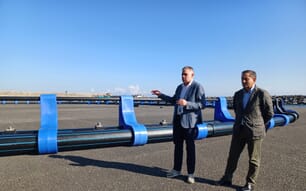The efficiency of pole-and-line fishing depends on the availability of baitfish of 6-9 cm in length, which is currently caught by boat-based lift nets, in coastal areas around tuna fishing grounds.
However, a trend towards reduced baitfish catches over recent years combined with conflicts with the use of baitfish for human consumption, which is a cheap source of seafood for local people, has significantly increased bait fish prices.
This situation has necessitated consideration of farming baitfish to ensure a sustainable supply to pole-and-line tuna fishers. Milkfish is one of the potential farmed fish that could be used as bait in the tuna industry, as it has been successfully trialed in the past.
Milkfish farming for food fish production is already well established in Indonesia and other countries such as the Philippines, Taiwan, and Pacific island countries. It is considered to be an environmentally sound farming system due to milkfish’s low food chain positioning - herbivorous or omnivorous feeding habit.
The purpose of this study, commissioned by the International Pole & Line Foundation (IPNLF) and conducted by WorldFish, is to review current experiences in the farming of milkfish and to prepare a feasibility study for development of viable milkfish bait supply for selected IPNLF priority locations in Eastern Indonesia.
The study was conducted with particular focus on Larantuka, Nusa Tenggara Timur (NTT) or East Flores province of Indonesia. The fieldwork was conducted during 1 April – 12 May 2014.
In detail, the study aimed to explore the possibility of milkfish fry as live bait for pole-and-line fisheries from both an economic point of view as well as technical viability, in order to overcome the problem of bait scarcity for poleand- line fisheries throughout Indonesia.
At present, there are about 104 pole-and-line fishing boats in Larantuka. Of these, only 50 are active due to the severe scarcity of baitfish. If all the 104 boats were active and undertook 10 fishing trips per month, then they would require 5,200 baskets of bait per month (41.60 million live bait per month).
There is seasonal variation in tuna catches, with tuna available only for 8 months of the year. The fishing is very low or no fishing is carried out during 4 months of the year, i.e. January
February and July-August. Therefore, the annual bait requirement (for 8 months only) is approximately 332.80 million (41,600 baskets) for all 104 boats or 160 million (20,000 baskets) for 50 active boats.
The present market price of live wild bait is IDR 300,000–425,000 per basket (IDR 37.50–53 per bait). Therefore, the estimated annual value of baitfish supply for 41,600 baskets in Larantuka at present price is about IDR 12.48 – 17.68 billion (US$ 1.45 million).
Since there is demand for additional bait for the currently inactive pole-and-line boats and a need to overcome the shortage of bait fish supply during the peak tuna fishing period (160 million baitfsh per year), it is technologically and economically viable to set up a milkfish hatchery unit in Larantuka to produce eggs and fry.
Farming of milkfish from fry to bait size (6-9 cm) can be practiced in both brackish water and freshwater areas. However, there is no scope for brackish water farming due to the thick mangrove forests in the coastal area of Larantuka.
Therefore, the freshwater farming was chosen; paddy-cum-milkfish farming is the most suitable and sustainable method that can be tested through trials and if feasible, promoted on commercial scale in Larantuka.
This report presents the experiences in bait milkfish farming in Larantuka, assessment of the technical and economic feasibility and business model of hatchery and farm construction and operation. The potential role of different value chain actors and actions to be taken for effective implementation of a milkfish bait farming programme at commercial scale are presented.
October 2014



